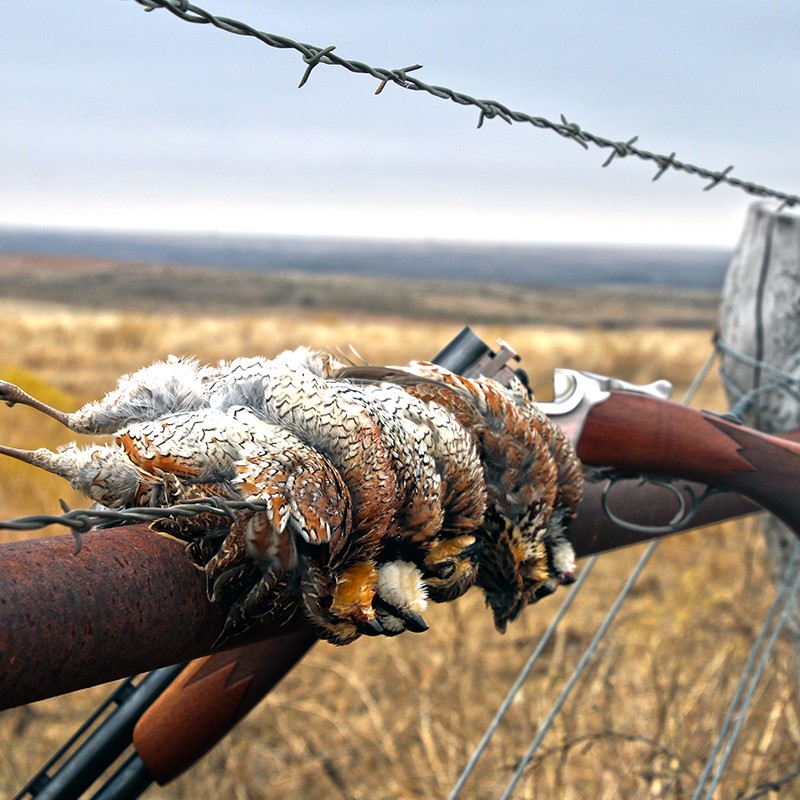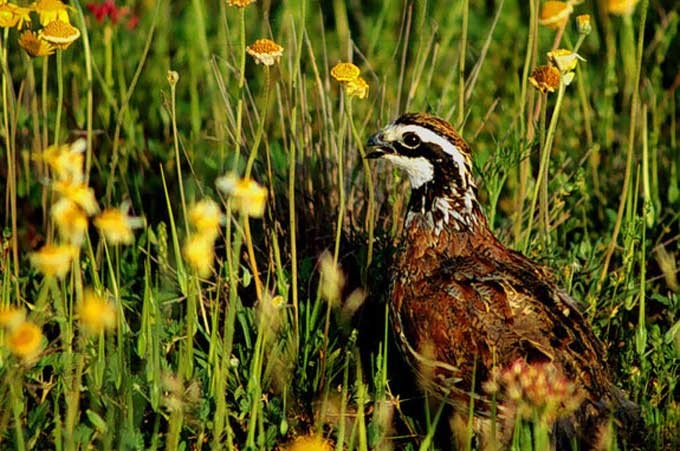By Kenneth L. Kieser
Regaining what seemed lost forever is a gift that’s hard to beat. Many of us grew up hunting coveys of quail on farms. My family’s 160-acre farm had at least three bobwhite quail coveys and quality hunts until the early 1990s.
The passing of time eliminated quail on our property and many others throughout the country. Quail hunts became memories of the good old days. That has changed in Kansas and many other areas around the country as Gentleman Bob returns.
KANSAS QUAIL
Bruce Wundrack and Robin Barrows recently enjoyed a vision of the old days while watching their setters, Sadie, Molly and Emma, work a milo field. The dogs worked in harmony while studying each crevice or grass-filled dip where a bobwhite quail might hide.
Both hunters were engrossed watching their prized dogs work. The dogs were excited by fresh, strong scents of Gentleman Bob a few yards away. Each dog stepped and occasionally hopped forward while moving closer to a hidden covey. Their eyes scanned down the rows for a tell-tale sign of their prey.
A hunter’s dream came to life when all three dogs became extremely birdy. The dogs went into a trance as instincts and training took over. Each dog intensely burrowed its nose into the tell-tale scents that bobwhite quail produce. The dogs' pace slowed down and intense eyes peered into the thickest cover of grass and milo stems.
Suddenly a dog on the left froze into a stone-hard point followed by the other dogs honoring in their own solid fashion. Wundrack and Barrows slowly moved into the low maze of vegetation, moving each boot forward as if walking through a mine field. The lead dog shivered as both hunters moved past, lightly kicking the grass.
The chilly morning air quickly reverberated with the “BBBBRRRRR” of flushing quail intent on escape. Both hunters shot and two quail dropped. The dogs made quick retrieves and soon another point and then another proving the good old days had returned — at least in that beautiful milo field.
Both men limited out that day and enjoyed watching their dogs work more coveys.
“I have seen an increase in quail numbers over the past six years, the number of years I have hunted Kansas,” Burrows said. “The first years we hunted, the state had suffered a two-year drought and bird numbers were down, but my dog Molly still found a few. The birds have steadily increased since then and hunting has become good in both eastern and western Kansas. Farmers are doing more by providing edge cover around row crops. Many finally realized that it’s difficult for quail to survive when agricultural pesticides eliminate all the bugs. No bugs mean no food for young quail and, sadly, equals no birds.”

Many hunters throughout Kansas are having memorable hunts through Kansas's poular
Walk-In Program whereby landowners are paid to allow hunters opportunities to hunt.
KANSAS PHEASANTS
I joined a group in Barton County, Kansas, close to the Cheyenne Bottoms Wildlife Area and the Quivira National Wildlife Refuge in 2016. The surrounding area is dominated by flat CRP or row crop fields cut by dirt or sandy back roads. This loose sand and dirt are almost like driving on ice-covered roads.
Blue sky over a vast ocean of light yellow prairie grass created a beautiful picture. A legion of yellow and black Labrador retrievers worked back and forth through the waist-high grasses, closely followed by determined men sporting orange hunting vests and hats. Several carried a pigeon grade shotgun, while others relied on their old field grade models. All lusted for roast pheasant or even a pheasant casserole.
We worked several fields and I was graciously asked to be a blocker, perhaps to avoid slowing our younger group down. Brent Frazee, former outdoor editor of the Kansas City Star joined me, and we enjoyed mild temperatures and warm sunshine.
In fact, our outfitter told me that we would probably shoot some birds, but it was too early for hunters to likely limit out. The best hunting takes place when the wind is blowing, snow covers the fields and the temperature is low.
Our hunters persisted and were soon rewarded by a cock pheasant’s flush. The bird looked huge as it pumped powerful wings to escape. We watched one of the hunters lead the bird and drop it with a well-placed shot from his 20 gauge.
The group moved toward my blocking position when someone stepped on a ‘landmine.’ A combination of cackling with heavy, flailing wings erupted from the tall grass to my left. I looked up in time to see three rooster pheasants fly 20 feet over my head. Their vibrant colors, including red, purple, yellow and green were luminescent in the sunlight against the bright blue sky. Cackling sounds of panicked birds filled the air as they quickly increased distance from danger. I watched as one dropped farther up the field. The others disappeared over a rise for future hunters to chase.
BRIGHT FUTURE
Kansas is bringing back quail and pheasants with a variety of habitat programs. The State Wildlife Habitat Improvement program works with landowners that don’t qualify for federal programs. A program through the U.S. Department of Agriculture provides funding allocated to wildlife habitat improvement. CRP practices include Bobwhite Buffers and Pivots Corners.
Kansas has two quail initiative areas: Melvern and Grand Osage. Grand Osage is still being developed and requires a permit to hunt. Melvern Wildlife Area, located in northeastern Kansas less than 20 miles from Emporia is one of the quail initiative areas. This area includes 4,000 acres of prairie grass, 3,000 acres of row crops and 2,000 acres of woodlands. Row crops are rotated and the area is burned off to improve wildlife conditions, notably quail habitat.
 Hunters on Melvern are required to get a free daily hunting permit through the Kansas Department of Wildlife and Parks electronic permit system. Permits are only required on certain areas of Melvern, so please check their regulations. I have hunted this region for quail on several occasions with great success. The hunting is generally thick grass with openings on edges and around woodlots.
Hunters on Melvern are required to get a free daily hunting permit through the Kansas Department of Wildlife and Parks electronic permit system. Permits are only required on certain areas of Melvern, so please check their regulations. I have hunted this region for quail on several occasions with great success. The hunting is generally thick grass with openings on edges and around woodlots.
EXCELLENT PUBLIC HUNTING OPPORTUNITIES
The big news for hunters is the Walk-In Hunting Access (WIHA) program, part of Kansas's overall
public hunting effort, one of America’s most successful, which is adding additional hunting throughout the state. The quail and pheasant cover is rated good to excellent in many of these areas.
"We have a lot of success in Kansas due to the walk-in program,” says Scott Killingsworth, Kansas, hunter.
"We hunt the southern half of Kansas during the colder months. Our selected areas have good numbers of quail. We find a lot of big coveys and take young hunters out whenever possible.”
Wildlife biologists credit recent drought years for indirectly playing a part in creating ideal habitat for the gamebirds. “When we were in the drought, cattle grazed a lot of the pastures way down,” said Jeff Prendergast, an upland gamebird biologist for the Kansas Department of Wildlife, Parks and Tourism. “When we got the rain last year and especially this year, a lot of the thin, weedy vegetation that quail like filled those pastures.”
Surveys by the Kansas Department of Wildlife, Parks and Tourism indicate counts were up 45 percent from 2015 and last year’s numbers were good. The south-central region had the highest quail numbers in surveys. The north-central, the northwest and parts of the Flint Hills also have good bobwhite densities.
“I’m talking to landowners who tell me that they’re seeing more quail and pheasants than they have in last 20 years,” said Larry Bailey, an avid quail hunter from Fort Scott, Kansas. “The hunting was good last year. We found more quail than we had the five previous years, but I think it will be even better this year.”
QF AND PF AT WORK
Kansas and neighboring Missouri are home to a combined 34 local Quail Forever chapters and 47 Pheasants Forever chapters. With more than 10,000 members in the two states, Howard Vincent, Quail Forever Pheasants Forever President and CEO, says it's time to bring back and keep strong quail and pheasant numbvers in these states.
"Kansas is one of the elite states for quail hunting, pheasant hunitng and wildlife habitat conservation. Both Kansas and Missouri are positioned as clear leaders in efforts to restore bobwhite quail populations," Vincent said. "Only time and good area management will make this possible. Persistent hunters, biologists and landowners are determined to continue reviving Kansas quail and pheasant numbers."